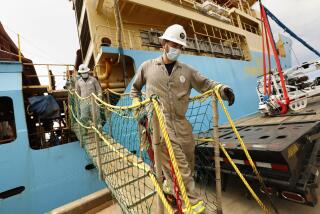Study Urges Trawling Ban in Fragile Marine Habitats
- Share via
Dragging nets along the ocean floor, a widely used method of commercial fishing, causes such devastation to sea life that the practice should be banned from areas with fragile marine habitat, federal researchers concluded Monday.
A report released by the National Academy of Sciences points out numerous areas of concern along the Pacific Coast, the North Atlantic, the Gulf coasts and waters around Alaska.
It also recommends that the federal government reduce bottom trawling, as the practice is called, and require trawlers to modify their gear to minimize damage.
The study, requested by the National Marine Fisheries Service, was applauded by some fishing and environmental groups that liken bottom trawling to chain sawing forests as a way to hunt for deer.
“This is clear-cutting the oceans, but because it happens out of sight and out of mind, nobody pays any attention to it,” said Elliott Norse, president of the Marine Conservation Biology Institute in Redmond, Wash. “So this [report] is huge. The National Academy of Sciences has outed the issue and now it will finally be dealt with.”
The marine fisheries service, which manages commercial fishing, said the scientific recommendations come at a key time: when its fisheries management councils are preparing studies on the best protection for critical ocean habitat in five different regions.
Rebecca Lent, the fisheries service deputy director, said the report underscored a critical point: “We need to reduce fishing efforts because we have too many boats chasing too few fish.”
Moreover, she said, the report pointed out the need for better mapping of essential habitat so federal officials know which areas of sea floor to protect.
Meanwhile, a bipartisan group of Congress members, frustrated by the slow pace of reform, is set to introduce legislation today to restrict bottom trawling.
The proposed Ocean Habitat Protection Act would ban fishing trawlers from using large rollers and “rock-hopping” wheels that allow their nets to bounce through rocky terrain without getting snagged.
It is this multilayered sea floor that is most susceptible to long-term damage, as weighted nets pulverize coral, sponges, sea grass and rocks used as feeding grounds and hiding places for juvenile fish.
“As an avid fisherman,” said Rep. Joel Hefley (R-Colo.), “I have strong concerns about the future of fishing and the devastating effects of mobile fishing gear.”
The legislation has brought together support from environmental groups such as the American Oceans Campaign as well as the recreational fishing lobby. Recreational anglers blame commercial trawling for ruining fishing for everyone else.
“This gear is destructive,” said Michael Doebley of the Recreational Fishing Alliance, which represents 70,000 anglers.
Yet the commercial fishing lobby opposes the idea, as well as any other restrictions that would cut into the supply of seafood for American consumers.
“Rather than wasting time on frivolous legislation or litigation,” said Rod Moore of the National Fisheries Institute, he suggested everyone follow just one of the recommendations made in the report--to have “scientists and the seafood industry work together more effectively.”
The report, written by the academy’s National Research Council, examined the ecological impacts of trawl nets used to snare cod in Alaskan waters, and shrimp in the Gulf of Mexico and along the Pacific Coast. The report also scrutinized the effects of steel-teeth dredges that scoop up scallops and oysters in New England and off the mid-Atlantic states.
Bottom trawling has been around for decades, sweeping across soft, sandy ocean bottom for flounder, haddock, shellfish and shrimp. Only since the 1980s, however, have trawl boats equipped their nets with rollers allowing them to scour deep, uneven terrain that functions as fish nurseries.
The disturbance to the ocean bottom varies widely, as does its recovery time, according to the report. The report says that besides scraping away cold-water coral, sponges and various plants, a single pass of a trawl wipes out 68% of sea anemones and 21% of starfish. Repeated passes, the report maintains, results in a 93% reduction in these bottom-dwelling creatures.
California has set some restrictions on bottom trawling in waters within three miles of shore. Georges Bank off the coast of Maine has closed some areas to help them recover, and the Dry Tortugas marine reserve off the tip of Florida has also banned bottom trawling.
Generally, though, the ocean is wide open to trawls, researchers noted, concluding that “closed areas are necessary to protect a range of vulnerable, representative habitats.”
More to Read
Sign up for Essential California
The most important California stories and recommendations in your inbox every morning.
You may occasionally receive promotional content from the Los Angeles Times.












